 The concept car of this series was introduced by Toyota in 1989, based on the Toyota Celica platform. Series production of the compact crossover began in 1994, and a year later the car entered the world market.
The concept car of this series was introduced by Toyota in 1989, based on the Toyota Celica platform. Series production of the compact crossover began in 1994, and a year later the car entered the world market.
In total, five generations of Toyota Rav4 have been produced. The last version has been produced since 2018.
It is distinguished by angular brutal design, LED headlights, unusual 18-inch wheels. Toyota RAV4 is recognized as the safest car according to Euro NCAP. The configuration of the SUV is one of the "richest" among the cars of this class.
Advantages and disadvantages
The list of pros and cons is compiled by the reviews of owners and the results of test drives.
Among the advantages of the car are named:
• attractive design;
• dynamism;
• safety;
• optional four-wheel drive system, allowing you to easily travel off-road;
• good controllability;
• comfortable interior and high quality of finishing.
Thanks to the sensitive steering wheel and rigid body, the car holds the road well and easily fits into corners. It is stable and does not react to side winds.
Disadvantages of the car:
• Slow response when you press the gas pedal - there is a 1-2 second pause.
• Unfortunate appearance (for the lover) and little functionality of the multimedia system.
• Sharp irritating illumination of the dashboard.
In opinion of many owners, volume of a trunk is not enough for a crossover.
Common problems and malfunctions: weaknesses of the machine
According to the opinion of car enthusiasts, the Toyota RAV4 is among the most reliable crossovers. However, this model also has weaknesses and characteristic "sore spots".
Engine
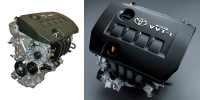 The 2L 3ZR-FE engine is considered reliable. Some problems have occurred in the pre-styled models. After 50,000 km mileage the control unit of the Valvematic system, which changes the height of the intake valve lift, was failing. This unit cost about 40 thousand rubles and can not be repaired. After the restyling it was decided not to install the actuator.
The 2L 3ZR-FE engine is considered reliable. Some problems have occurred in the pre-styled models. After 50,000 km mileage the control unit of the Valvematic system, which changes the height of the intake valve lift, was failing. This unit cost about 40 thousand rubles and can not be repaired. After the restyling it was decided not to install the actuator.
The 2.5-liter 2AR-FE gasoline engine has no complaints. Compared to the 3ZR it is more reliable and has a longer service life.
The frequent problem of all Toyota RAV4 2017 gasoline units is the cooling system pump leaking after about 100 thsd. km. The replacement cost is about 280 dollars.
The 2.2-liter diesel engine has several drawbacks:
• On pre-reduced models, the gasket on the cylinder head quickly loses its tightness. The consumption of coolant and oil increases, and soot builds up on the pistons. After restyling, this flaw was eliminated.
• Overfilling of fuel injectors leads to engine wear and piston burnout.
* The front engine cover leaks after 30-40 thousand km run. The problem is typical for models released before February 2015.
Variator
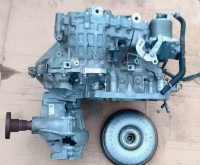 Reliability of manual transmission and "classic" 6-speed automatic does not cause complaints among Toyota RAV4 2017 owners. The weak point is often the variator. It reacts badly on sharp braking and skidding, fast acceleration and low temperatures.
Reliability of manual transmission and "classic" 6-speed automatic does not cause complaints among Toyota RAV4 2017 owners. The weak point is often the variator. It reacts badly on sharp braking and skidding, fast acceleration and low temperatures.
With aggressive driving style and low quality of maintenance the breakdowns start after 100 000 km.
The most common problems with variators are
1. Bearing failure on the main shaft;
2. tension and failure of timing belt
3. ageing and deformation of gaskets and seals - as a result, they miss lubrication.
Among the operational disadvantages owners note too noisy operation.
 Front-wheel drive
Front-wheel drive
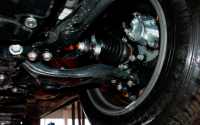 Toyota RAV4 with front-wheel drive copes well in the city and on the highway. But it is not enough for off-road driving. In addition, there are difficulties when climbing uphill on a winter road - the car begins to slip.
Toyota RAV4 with front-wheel drive copes well in the city and on the highway. But it is not enough for off-road driving. In addition, there are difficulties when climbing uphill on a winter road - the car begins to slip.
Front-wheel drive models often have worn or deformed pulleys, which leads to the failure of the entire mechanism.
Fuel system
Such malfunctions are caused by poor quality gasoline. Even a single refueling with bad fuel can lead to malfunctions.
Common fuel system problems include failure of
* injectors;
* throttle valve assembly;
* fuel pump.
Steering rack
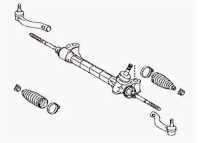 The disadvantage of the RAV4 is the rapid failure of the steering rack. The first malfunctions often occur after 50,000 km. With careful operation the service life reaches 100 thousand km.
The disadvantage of the RAV4 is the rapid failure of the steering rack. The first malfunctions often occur after 50,000 km. With careful operation the service life reaches 100 thousand km.
Frequent failures of steering mechanism:
1. Power steering fluid leakage. The problem is caused by tears or cracks on sealing rings. The fluid level in the tank lowers, and a puddle may form under the vehicle.
2. Failure of the bushing. Knocks and strong vibration of the steering wheel appear when driving on an uneven road.
3. Increased backlash and decreased sensitivity of steering when driving on a smooth surface.
After completion of the turning maneuver, the steering wheel does not return to its original position. If the faults are not eliminated in time, it threatens the failure of the entire mechanism. Full replacement will require a large monetary investment.
Suspension
 Frequent problems with the front axle are:
Frequent problems with the front axle are:
1. Low life of stabilizer bushings. They have to be replaced after 40-50 thousand km.
2. Destruction of hub pins - when they are tightened tightly, their threads are torn off.
3. Failure of front lever assemblies.
4. Bearing failure.
Common drawbacks of the rear suspension are considered to be:
1. Soft silent blocks. They are easily punctured when driving on rough roads.
2. oxidation of the camber arms, leading to problems when adjusting wheel geometry.
3. Failure of the rear stabilizer strut mounts.
Replacement of suspension parts is required after 50-60 thousand km of mileage.
Failure of cooling system components
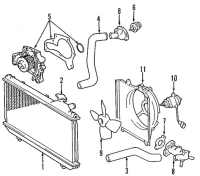 With proper maintenance and regular cleaning, the crossover cooling system is trouble-free.
With proper maintenance and regular cleaning, the crossover cooling system is trouble-free.
Otherwise, the following malfunctions occur:
1. The radiator becomes clogged with dirt and dust particles.
2. Antifreeze leaks from the system.
3. the coolant is squeezed out through the plug.
All this leads to overheating of the engine and its failure.
Paint quality

The disadvantage of the Toyota RAV4 2017 is the poor quality paintwork. Chips and scratches quickly appear on a thin layer of paint. Because of this the body metal is exposed to corrosion.


